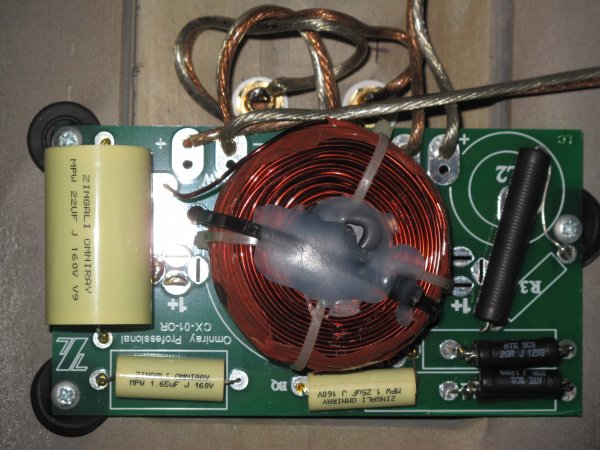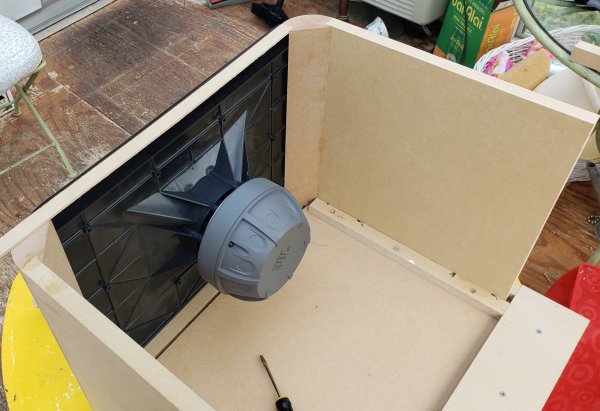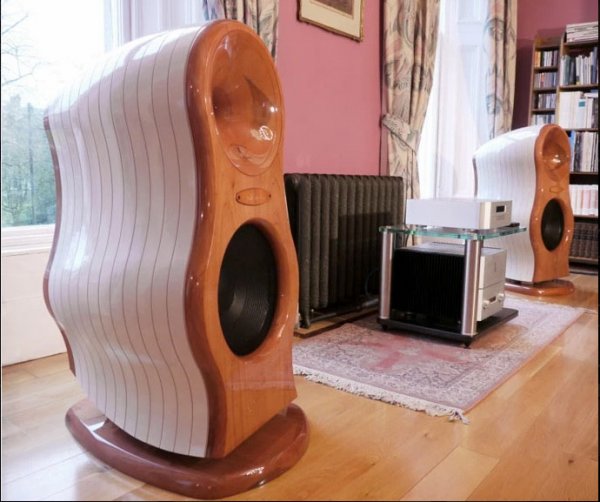keep in mind also that this is IPhone recorded...that thins out the sound considerably...Hi Brad, from my opinion the horn's level is to loud and I'd recommend trying out another filter than LR - for example BW... anpther thing is to find the right slopes but you have to measure it first.
Good luck
First trials of active horn speaker
- Thread starter morricab
- Start date
You are using an out of date browser. It may not display this or other websites correctly.
You should upgrade or use an alternative browser.
You should upgrade or use an alternative browser.
Cool, is that the JBL M2 waveguide? Are you using the JBL driver that goes with it (can't remember the model number) that is a dual diaphragm design? Will you be using digital xover with DSP?
Hello Morricab
Yes it is the M2 waveguide but I am using a different compression driver the JBL 476Mg. It's a large format 4" driver with a coated magnesium diaphragm. Much more output than a 2430 down low. I am also going passive, I have the compression driver comp done. Might need a little tweak with padding and from listening impressions as I am only working with on axis measurements for now but it's essentially done. I have to measure the woofer in the cabinet and do the low pass crossover from there.
I am setting up the 2216nd in a low tuned 26Hz cabinet so I can dial up the low bass as required. Gives you a nice banana curve so with any room gain you don't get overwhelmed and you can add a little EQ at Fb where drivers excursion is lowest. That EQ will be done with digital EQ.
Rob
Yes it is the M2 waveguide but I am using a different compression driver the JBL 476Mg. It's a large format 4" driver with a coated magnesium diaphragm.
My understanding is that the M2 waveguide has a 1" throat, and I would expect a "large format" compression driver to have either a 1.4" or 1.5" or 2" throat.
If so, how are you adapting the 476 Mg to the M2 waveguide?
Or, am I missing something?
Last edited:
Hello Duke
No it's a 1.5" throat so no adapter needed. It was a nightmare getting the 1/4 20's snugged up but other than that any large format with the small bolt pattern drops right on. Looks like there is enough room to accommodate a larger bolt pattern on some drivers like a 2451. Just have to modify the horns mounting plate. Here is a picture of a 435Be mounted to one of the horns
No it's a 1.5" throat so no adapter needed. It was a nightmare getting the 1/4 20's snugged up but other than that any large format with the small bolt pattern drops right on. Looks like there is enough room to accommodate a larger bolt pattern on some drivers like a 2451. Just have to modify the horns mounting plate. Here is a picture of a 435Be mounted to one of the horns
Attachments
No it's a 1.5" throat so no adapter needed...
Thank you. I was wondering how JBL got away with crossing over what I thought was a 1" throat compression driver so low, without trashing the power handling. The 1.5" throat explains it; it's a large-format compression driver.
In which case: Kudos to JBL for getting good radiation pattern width in the top octave (and especially in the top 1/2 octave) out of a 1.5" throat driver WITHOUT using a diffraction slot! Or if that strange topography IS a diffraction slot of some kind, to my ears it is startlingly (and ime uniquely) benign for the type. I guess that's what JBL pays their legendary engineering staff the big bucks for.
I think DSP is necessary to get the top octave right as this is a constant directivity design. I am doing this with both my horns even though the Iwata is not a cd type horn. I will also experiment with that compensation turned off for the Iwata.Thank you. I was wondering how JBL got away with crossing over what I thought was a 1" throat compression driver so low, without trashing the power handling. The 1.5" throat explains it; it's a large-format compression driver.
In which case: Kudos to JBL for getting good radiation pattern width in the top octave (and especially in the top 1/2 octave) out of a 1.5" throat driver WITHOUT using a diffraction slot! Or if that strange topography IS a diffraction slot of some kind, to my ears it is startlingly (and ime uniquely) benign for the type. I guess that's what JBL pays their legendary engineering staff the big bucks for.
I think DSP is necessary to get the top octave right as this is a constant directivity design. I am doing this with both my horns even though the Iwata is not a cd type horn. I will also experiment with that compensation turned off for the Iwata.
Yes, constant-directivity horns must be EQ'd. And if the compression driver's output is drooping a bit in the top half-octave or so (often the case with large format compression drivers), they may be boosting that top half-octave a bit. But EQ can't do diddly about the radiation pattern itself - in this case I think it's the horn that controls the radiation pattern up high, but it's not obvious to me just exactly what the horn is doing.
Interesting that they call it an "Image Control Waveguide." There's probably a clue in that wording.
[speculation] IF those tall, narrow bumps to either side of the 1.5" throat are what give the M2's horn its wide pattern at high frequencies via what might be called "sparingly-applied diffraction", then it seems to me its exceptional pattern width would be confined to a fairly narrow vertical window centered on the horn's throat. Can't help but wonder what its pattern would look like in other planes, such as along the diagonals... but that may not matter much in practice. [/speculation]
Last edited:
Interesting project Brad. I can understand manufacturers of speakers must spend thousands of hours tuning various drivers and crossovers, playing with cabinet construction ect.
I think all speakers have a target sound, the designer perceives as his ideal. Then costs factored in of course.
I have built a few DIY DACs and tried various capacitors from different manufacturers. It really affected the sound,particularly on the coupling position, and even on the PS regulation positions.
I am playing with my Zingali crossovers at the moment. Not anything as radical as your project, rather a tweaking exercise, trying to wring a bit more out of them. Speakers are hugely affected by room acoustics as we know. If a designer has them zero'd in a mock home setting in the factory, how do we know they will sound the same in our own room? I guess we don't.

So my thoughts on tweaking the sound, is play with different caps on the passive crossover, and then finally look at the attenuation of the 2 drivers in my setting. I get the feeling the horn is attenuated a bit too much. My (work based) music room is smaller than my demo room, and is getting more loaded with bass because of that.
I will rebuild the caps first, then after some weeks of burn in, look at different attenuation on the horn, maybe reduce it a bit. It is on 10 ohms at the moment, I may try half that, see what that sounds like.
This subject is interesting. It is not something I see talked about much, more leave the speakers as they were designed kind of approach. That is true, but there is always room for improvements, even if just upgrading the caps. Caps tend to be ok in mid priced speakers, but not the best.
I am trying the better Mundorfs. I couldn't get Duelunds in the values I needed, only the VSF types, and they are crazy money.
Back to Brad's project, sorry I digressed a bit. I don't think me little project needs a separate thread.
I think all speakers have a target sound, the designer perceives as his ideal. Then costs factored in of course.
I have built a few DIY DACs and tried various capacitors from different manufacturers. It really affected the sound,particularly on the coupling position, and even on the PS regulation positions.
I am playing with my Zingali crossovers at the moment. Not anything as radical as your project, rather a tweaking exercise, trying to wring a bit more out of them. Speakers are hugely affected by room acoustics as we know. If a designer has them zero'd in a mock home setting in the factory, how do we know they will sound the same in our own room? I guess we don't.

So my thoughts on tweaking the sound, is play with different caps on the passive crossover, and then finally look at the attenuation of the 2 drivers in my setting. I get the feeling the horn is attenuated a bit too much. My (work based) music room is smaller than my demo room, and is getting more loaded with bass because of that.
I will rebuild the caps first, then after some weeks of burn in, look at different attenuation on the horn, maybe reduce it a bit. It is on 10 ohms at the moment, I may try half that, see what that sounds like.
This subject is interesting. It is not something I see talked about much, more leave the speakers as they were designed kind of approach. That is true, but there is always room for improvements, even if just upgrading the caps. Caps tend to be ok in mid priced speakers, but not the best.
I am trying the better Mundorfs. I couldn't get Duelunds in the values I needed, only the VSF types, and they are crazy money.
Back to Brad's project, sorry I digressed a bit. I don't think me little project needs a separate thread.
I don't think all capacitors are upgrades even if they cost more. You have to watch the ESR in caps or you might screw up the crossover. Generally all normal film is low, but PIO and certain others may be higher.
The horn tweeter resistor, is it series or? That affects which way the values go.
The horn tweeter resistor, is it series or? That affects which way the values go.
Thanks. Yes the ESR, I will measure the old and new caps to compare. Mundorfs should be low ESR I think, they are used in crossovers a lot, Magico for example.
The resistors are Parallel, 2 stacked on each leg. 20R + 20R = 10R resistance I think, so I can try some lower values, see how that sounds.
The Zingalis (I have met the designer) are tuned to play with high end or low end systems, so I think they are playing safe on the treble extension. My front end is super smooth so I can try extending it a bit. I'll post back here end next week with a report.
I get the impression the horn is more efficient than the woofer, so plenty of movement is possible re balance in my room setup. Wonder what dB drop 10R is?
Just checked, and if the caps are indeed Poly types metalized film, probably IC make (Illinois Capacitor) the ESR for a 22uf is a low 0.118ohms. The ESR for the Mundorf 22uF is around 0.05ohms. So In think should be ok, not shift too much.
The resistors are Parallel, 2 stacked on each leg. 20R + 20R = 10R resistance I think, so I can try some lower values, see how that sounds.
The Zingalis (I have met the designer) are tuned to play with high end or low end systems, so I think they are playing safe on the treble extension. My front end is super smooth so I can try extending it a bit. I'll post back here end next week with a report.
I get the impression the horn is more efficient than the woofer, so plenty of movement is possible re balance in my room setup. Wonder what dB drop 10R is?
Just checked, and if the caps are indeed Poly types metalized film, probably IC make (Illinois Capacitor) the ESR for a 22uf is a low 0.118ohms. The ESR for the Mundorf 22uF is around 0.05ohms. So In think should be ok, not shift too much.
Last edited:
Do you know what driver is behind the horn? If it is a compression driver then the horn/driver is at least 10db more sensitive.Thanks. Yes the ESR, I will measure the old and new caps to compare. Mundorfs should be low ESR I think, they are used in crossovers a lot, Magico for example.
The resistors are Parallel, 2 stacked on each leg. 20R + 20R = 10R resistance I think, so I can try some lower values, see how that sounds.
The Zingalis (I have met the designer) are tuned to play with high end or low end systems, so I think they are playing safe on the treble extension. My front end is super smooth so I can try extending it a bit. I'll post back here end next week with a report.
I get the impression the horn is more efficient than the woofer, so plenty of movement is possible re balance in my room setup. Wonder what dB drop 10R is?
I warned him of the same thing...I don't think all capacitors are upgrades even if they cost more. You have to watch the ESR in caps or you might screw up the crossover. Generally all normal film is low, but PIO and certain others may be higher.
The horn tweeter resistor, is it series or? That affects which way the values go.
Some interior pics
ESR not an issue I think, as not going from Eletrolytics to film, are film already. And prob 0.118ohm for the old caps.
Yes 10dB sound about right Brad, thanks. There is a 2 x pair 20R resistors in Parallel which = 10ohms which may be about 10dB drop?
I am considering trying a 10R + a 20R to give me a drop in attenuation, bring the horn up a bit in volume. I'll use the right channel speaker as a datum, untouched, so I have a way to track the changes, good or bad, hopefully GREAT. But.....
ESR not an issue I think, as not going from Eletrolytics to film, are film already. And prob 0.118ohm for the old caps.
Yes 10dB sound about right Brad, thanks. There is a 2 x pair 20R resistors in Parallel which = 10ohms which may be about 10dB drop?
I am considering trying a 10R + a 20R to give me a drop in attenuation, bring the horn up a bit in volume. I'll use the right channel speaker as a datum, untouched, so I have a way to track the changes, good or bad, hopefully GREAT. But.....
Last edited:
Could be a B&C driver then... I think they are Italian. The body doesn't really look like an 18 Sound or Faital Pro driver.Hi Brad
Yes it is a compression driver. They used to use JBL, but later had them made by contract in Italy.
View attachment 64464View attachment 64465View attachment 64466View attachment 64467
Although it does look a lot like this one from B&C
https://www.bcspeakers.com/en/products/hf-driver/1-3/8/de910tn
https://www.bcspeakers.com/en/products/hf-driver/1-3/8/de910tn
Similar threads
- Replies
- 3
- Views
- 866
- Replies
- 0
- Views
- 538
- Replies
- 0
- Views
- 381
- Replies
- 4
- Views
- 945
- Replies
- 22
- Views
- 3K










